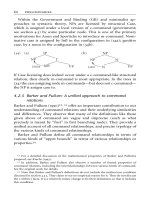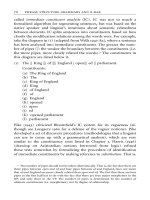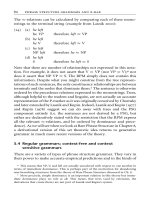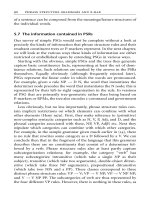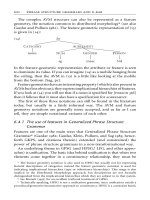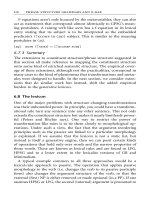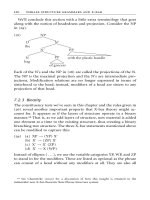Constituent Structure - Part 12
Bạn đang xem bản rút gọn của tài liệu. Xem và tải ngay bản đầy đủ của tài liệu tại đây (109.61 KB, 10 trang )
of a sentence can be composed from the meanings/feature structures of
the individual words.
5.7 The information contained in PSRs
Our survey of simple PSGs would not be complete without a look at
precisely the kinds of information that phrase structure rules and their
resultant constituent trees or P-markers represent. In the next chapter,
we will look at the various ways these kinds of information are either
restricted or embellished upon by extending PSGs in various ways.
Starting with the obvious, simple PSGs and the trees they generate
capture basic constituency facts, representing at least the set of dom-
inance relations. Such relations are marked by the arrows in the PSRs
themselves. Equally obviously (although frequently rejected later),
PSGs represent the linear order in which the words are pronounced.
For example, given a rule NP ! D N, the word that instantiates the
determiner node precedes the word that instantiates the N node; this is
represented by their left-to-right organization in the rule. In versions
of PSG that are primarily tree-geometric rather than being based on
P-markers or RPMs, the tree also encodes c-command and government
relations.
Less obviously, but no less importantly, phrase structure rules con-
tain implicit restrictions on which elements can combine with what
other elements (Heny 1979). First, they make reference to (primitive)
non-complex syntactic categories such as N, V, P, Adj, and D, and the
phrasal categories associated with these, NP, VP, AdjP, etc. Next they
stipulate which categories can combine with which other categories.
For example, in the sample grammar given much earlier in (14), there
is no rule that rewrites some category as a D followed by a V. We can
conclude then that in the fragment of the language that this grammar
describes there are no constituents that consist of a determiner fol-
lowed by a verb. Phrase structure rules also at least partly capture
subcategorization relations; for example, the category ‘‘verb’’ has
many subcategories: intransitive (which take a single NP as their
subject), transitive (which take two arguments), double-object ditran-
sitive (which take three NP arguments), prepositional ditransitive
(which take two NPs and a PP). These classes correspond to three
distinct phrase structure rules: VP ! V; VP ! VNP;VP! VNPNP;
and V ! V NP PP. The subcategories of verb are thus represented by
the four diVerent VP rules. However, there is nothing in these rules, as
90 phrase structure grammars and x-bar
stated, that prevents a verb of one class being introduced by a rule of
adiVerent class. Without further restrictions (of the kind we will
introduce in Ch. 6), PSGs cannot stop the verb put, for example,
being used intransitively (*I put). PSGs, then, contain some, but not
all the subcategorization information necessary for describing human
language.
In summary, PSGs encode at least the following organizational
properties:
(39) (a) hierarchical organization (constituency and dominance rela-
tions);
(b) linear organization (precedence relations);
(c) c-command and government relations or local constraints (in
tree-dominant forms of PSGs only);
(d) categorial information;
(e) subcategorization (in a very limited way).
There are many kinds of other information that PSGs do not directly
encode, but which we might want to include in our syntactic descrip-
tions. Take the grammatical relations (Subject, Object, Indirect object,
etc.) or thematic relations (such as Agent, Patient, and Goal). Neither
of these are directly encoded into the PSRs; however, in later chapters,
we will see examples of theories like Lexical-Functional Grammar, in
which grammatical relations are notated directly on PSRs. Within the
Chomskyan tradition, however, grammatical relations can be read oV
of syntactic trees (for example, the subject is the NP daughter of S), but
they are not directly encoded into the rule.
Similarly, semantic selectional restrictions are not encoded in simple
PSGs. Selectional restrictions govern co-occurrence of words in a
sentence beyond (sub)categorial restrictions. For example, the verb
die in its literal sense requires that its subject be animate and alive.
Since it is an intransitive verb, it should appear in any context given by
the VP ! V version of the VP rule. However, its selectional restrictions
prevent it from appearing in sentences such as *The stone died.Un-
acceptability of this kind does not follow from PSGs themselves.
In all the examples we have considered thus far, with the exception of
the sentence (S) rule, the PSRs are always of the form where NPs are
always headed N, VPs by V, etc. This is the property of endocentricity.
This is particularly true of PSRs when they are construed as projection
formulas. A formal mechanism for stipulating endocentricity will be
discussed in Chapter 7, when we turn to X-bar theory (see also Ch. 8,
phrase structure grammars 91
where we discuss head-based dependency grammars). In simple PSGs,
however, nothing forces this result. Indeed, within the tradition of
generative semantics, as well as in LFG, one can Wnd unheaded phrase
structure rules where NPs dominated S categories without an N head,
or VPs dominated only an adjective, etc.
Finally, consider non-local relationships (that is, relationships other
than immediate precedence and immediate dominance) among elem-
ents in the tree. While we can deWne notions such as c-command over
trees, there is nothing inherent to PSGs that deWnes them. As such, in
order to indicate such relationships we need to extend PSGs with
notational devices such as indices or features. The same holds true
for long-distance Wller–gap relations (also known as ‘‘displacement
operations’’). For example, in the sentence What did Norton say that
Nancy bought ___? we want to mark the relationship between the wh-
word and the empty embedded object position with which it is asso-
ciated. This kind of information just is not available in a simple PSG.
In the next two chapters (and to a lesser degree other chapters later
in the book), we will look at how information already present in PSGs
is either limited or shown to follow from other devices (or slightly
diVerent formalizations). We will also look at the ways in which
information that is not part of simple PSGs has been accommodated
into the PSG system. In Chapter 6, we will look at such devices as the
lexicon, complex symbols (i.e. feature structures), indices, abbrevi-
atory conventions, a diVerent format for rules (the ID/LP format),
and transformations of various kinds which have all been proposed as
additions to simple PSGs so that the information they contain is either
restricted and expanded. Chapter 6 focuses on extended PSGs in early
Chomskyan theory, in GPSG (and to a lesser degree in HPSG), and in
LFG. In Chapter 7, we turn to the inXuential X-bar theory in its various
incarnations. The X-bar approach started oV as a series of statements
that restricts the form of phrase structure rules, but eventually devel-
oped into an independent system which allows us to capture general-
izations not available with simple PSRs.
92 phrase structure grammars and x-bar
6
Extended Phrase Structure
Grammars
6.1 Introduction
In the last chapter, we looked at a narrow version of a phrase structure
grammar. Here we consider various proposals for extending PSGs. We
are interested in things that PSRs do not do well and therefore require
extending mechanisms, and things that PSRs can do but would be
better handled by other components of the grammar.
We start with some minor abbreviatory conventions that allow
expression of iteration and optionality within PSGs. These conven-
tions are commonly found in most versions of PSGs.
Next we consider Chomsky’s Wrst extensions to PSGs: two kinds of
transformational rule: structure-changing transformations (SCTs) and
structure-building ‘‘generalized transformations’’ (GTs). These ac-
count for a range of data that simple PSGs appear to fail on. After
this we look at the alternatives Wrst proposed within the Generalized
Phrase Structure Grammar (GPSG) framework: feature structures for
stating generalizations across categories, and metarules, which oVer an
alternative to transformations and state generalizations across rule
types. We will also look at the immediate dominance/linear precedence
(ID/LP) rule format common to GPSG and LFG that allows us to
distinguish between rules that determine linear order and those that
determine hierarchical structure as well as other extensions that make
use of a distinct semantic structure.
Chomsky (1965) recognized the power of the lexicon, the mental
dictionary, in limiting the power of the rule component. Early versions
of this insight included mechanisms for reducing the redundancy
between lexical restrictions on co-occurrence and those stated in the
PSGs. Some of this was encoded in the feature structures found in
GPSG mentioned above. But the true advance came in the late 1970s
and early 1980s, when LFG, GB (Principles and Parameters), and HPSG
adopted generative lexicons, where certain generalizations are best
stated as principles that hold across words rather than over trees
(as was the case for transformations) or rules (as was the case for
metarules). This shift in computational power to the lexicon had a
great stripping eVect on the PSG component in all of these frame-
works, and was at least partly the cause of the development of X-bar
theory—the topic of Chapter 7.
6.2 Some minor abbreviatory conventions in PSGs
The ‘‘pure’’ PSGs described in Chapter 5, by their very nature, have a
certain clumsy quality to them. It has become common practice in
most theories (except GPSG, which uses a diVerent mechanism for
abbreviating grammars; see the section on metarules below) to abbre-
viate similar rules. Consider the rules that generate a variety of types of
noun phrases (NPs). NPs can consist of at least the following types: a
bare noun; a noun with a determiner; a noun with an adjectival
modiWer (AdjP); a noun with a determiner and an adjectival modiWer;
a noun with a prepositional phrase (PP) modiWer; a noun with a
determiner and a PP; a noun with an AdjP and a PP; and the grand
slam with D, AdjP, and PP. Each of these requires a diVerent PSR:
(1) (a) people NP ! N
(b) the people NP ! DN
(c) big people NP ! AdjP N
(d) the big people NP ! D AdjP N
(e) people from New York NP ! NPP
(f) big people from New York NP ! AdjPNPP
(g) the big people from New York NP ! D Adj N PP
In classical top-down PSGs, these have to be distinct rules. The deriv-
ation of a sentence with an NP like that (g), but with the application of
the rule in (d), will fail to generate the correct structure. Replacing NP
with AdjP and N (using d) will fail to provide the input necessary for
inserting a determiner or a PP (which are present in g). Each type of
NP requires its own rule. Needless to say, this kind of grammar quickly
94 phrase structure grammars and x-bar



